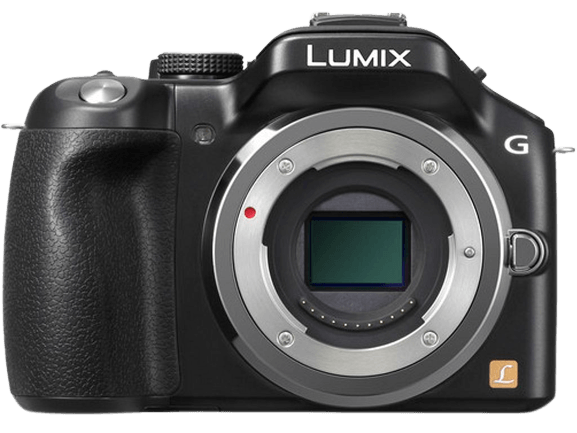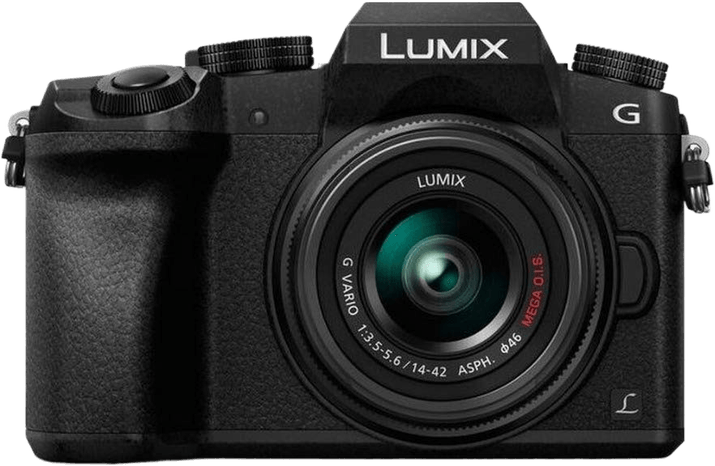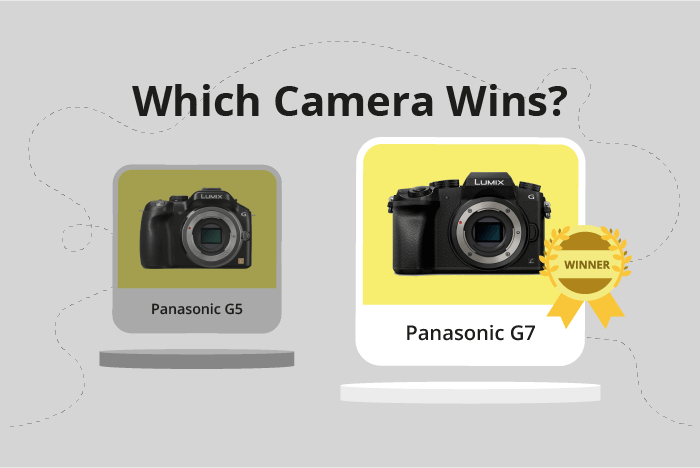Panasonic Lumix DMC G5 vs Lumix DMC-G7 Comparison
Panasonic Lumix DMC G5

Panasonic Lumix DMC-G7

The Panasonic Lumix DMC-G7 outperforms the Lumix DMC G5 with a score of 52/100 compared to 47/100. Both cameras are mirrorless and share similar dimensions and weight. The G7 is slightly larger and heavier at 125 x 86 x 77mm and 410g, while the G5 measures 120 x 83 x 71mm and weighs 396g.
The G7 offers better performance, which is reflected in its higher score. It was released in 2015, three years after the G5’s 2012 launch, and has a higher launch price of $799 versus the G5’s $650. This suggests that the G7 has more advanced features and technology.
On the other hand, the G5 has its advantages, including a lower price point and a slightly more compact design. This makes it a more budget-friendly and portable option for those who prioritize these factors.
Taking into account their scores, release dates, and prices, the Lumix DMC-G7 is the superior camera, offering better performance and features. However, the Lumix DMC G5 remains a viable option for those seeking a more affordable and compact camera.
Panasonic Lumix DMC G5 vs Lumix DMC-G7 Overview and Optics
The Panasonic Lumix DMC-G7 outperforms the Panasonic Lumix DMC G5 in optics, scoring 51/100 compared to the G5’s 46/100. Both cameras share several specifications, including a 16-megapixel CMOS sensor, Micro Four Thirds sensor size, Micro 4/3 lens mount, and lack of image stabilization.
The G7’s higher score is due to its faster shooting speed of 7fps compared to the G5’s 6fps, allowing for better action photography and continuous shooting. Moreover, the G7’s DXOMARK sensor score of 75 surpasses the G5’s score of 61, indicating better overall image quality, low-light performance, and dynamic range. The G7’s processor is unspecified, but its improved performance suggests a more advanced processor than the G5’s Venus Engine VII FHD.
On the other hand, the G5 has a slightly higher megapixel count at 16.05 compared to the G7’s 16, but this difference is negligible and does not significantly impact image quality. The G5’s Venus Engine VII FHD processor ensures decent performance, but it falls short compared to the G7’s capabilities.
In comparing the optics of these two cameras, the Panasonic Lumix DMC-G7 emerges as the superior option due to its faster shooting speed and higher DXOMARK sensor score. The Panasonic Lumix DMC G5 is a decent camera, but its lower score and performance make it less appealing for those seeking optimal image quality and speed.
Panasonic Lumix DMC G5 vs Lumix DMC-G7 Video Performance
The Panasonic Lumix DMC-G7 outperforms the Panasonic Lumix DMC G5 in terms of video capabilities, scoring 83/100 compared to the G5’s score of 56/100. Both cameras share some common features, such as a maximum video frame rate of 60fps. This similarity ensures that both cameras can capture smooth and high-quality video footage.
The DMC-G7 excels in video resolution and time-lapse functionality. It offers 4K video resolution, with maximum dimensions of 3840 x 2160, providing superior video quality and detail compared to the G5’s Full HD resolution (1920 x 1080). This significant difference in resolution allows users to capture sharper and more vibrant videos. Additionally, the DMC-G7 has built-in time-lapse functionality, enabling the creation of stunning time-lapse videos without the need for additional software or equipment.
On the other hand, the DMC G5 does not have any specific advantages in video capabilities over the DMC-G7. Its lower video score is a result of its limited features and performance in comparison to the DMC-G7.
Taking these factors into account, the Panasonic Lumix DMC-G7 is the clear winner in terms of video capabilities. Its superior video resolution and the inclusion of time-lapse functionality make it a more versatile and powerful camera for capturing high-quality video footage. The Panasonic Lumix DMC G5, while still capable of producing good quality videos, falls short in comparison due to its lower resolution and lack of time-lapse functionality.
Panasonic Lumix DMC G5 vs Lumix DMC-G7 Features and Benefits
The Panasonic Lumix DMC-G7 emerges as the winner in the feature comparison, scoring 58 out of 100 points, while the Panasonic Lumix DMC G5 scores 27 points. Both cameras share several specifications, such as a 3-inch screen size, touchscreen functionality, flip screen capability, and the absence of GPS and Bluetooth.
The Lumix DMC-G7 outperforms the DMC G5 in terms of screen resolution, boasting 2,360,000 dots compared to the DMC G5’s 920,000 dots. This higher resolution offers a clearer and sharper display for users. Additionally, the DMC-G7 includes Wi-Fi functionality, allowing users to connect the camera to a smartphone or other devices for easy sharing and remote control. This feature is absent in the DMC G5.
On the other hand, the Lumix DMC G5 does not have any distinct advantages over the DMC-G7 in terms of features. Both cameras have the same screen size, touchscreen capability, flip screen, and lack GPS and Bluetooth. The DMC G5’s lower feature score reflects the absence of any standout features compared to the DMC-G7.
Taking these factors into account, the Panasonic Lumix DMC-G7 is the superior camera in terms of features. Its higher screen resolution and Wi-Fi functionality provide a more enjoyable and convenient user experience. While the Lumix DMC G5 shares some common specifications with the DMC-G7, it does not offer any unique advantages that would make it a better choice for users seeking a camera with robust features.
Panasonic Lumix DMC G5 vs Lumix DMC-G7 Storage and Battery
The Panasonic Lumix DMC-G7 outperforms the Panasonic Lumix DMC G5 in storage and battery, scoring 35/100 compared to the G5’s 21/100. Both cameras share common specifications such as one memory card slot and compatibility with SD, SDHC, and SDXC memory cards.
The G7 holds an advantage in battery life, offering 350 shots per charge, while the G5 provides 320 shots. Additionally, the G7 supports USB charging, making it more convenient for on-the-go charging. The G5 lacks this feature.
The G5 does not offer any notable advantages in storage and battery compared to the G7. Both cameras use the same battery type, DMW-BLC12, but the G7 uses a slightly different version, DMW-BLC12E.
Considering these factors, the Panasonic Lumix DMC-G7 is the superior option in terms of storage and battery performance when compared to the Panasonic Lumix DMC G5.
Panasonic Lumix DMC G5 vs Lumix DMC-G7 – Our Verdict
Are you still undecided about which camera is right for you? Have a look at these popular comparisons that feature the Panasonic Lumix DMC G5 or the Panasonic Lumix DMC-G7:

